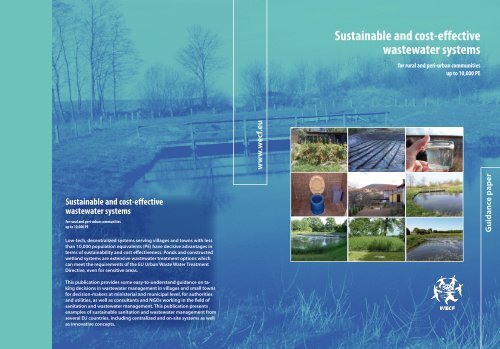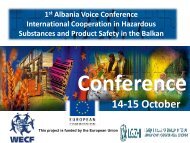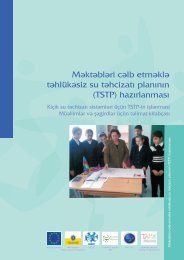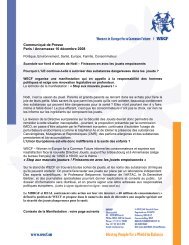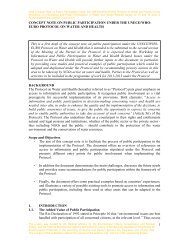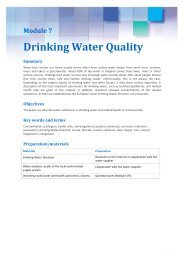Sustainable and cost-effective wastewater systems for rural - wsscc
Sustainable and cost-effective wastewater systems for rural - wsscc
Sustainable and cost-effective wastewater systems for rural - wsscc
Create successful ePaper yourself
Turn your PDF publications into a flip-book with our unique Google optimized e-Paper software.
<strong>Sustainable</strong> <strong>and</strong> <strong>cost</strong>-<strong>effective</strong><strong>wastewater</strong> <strong>systems</strong><strong>for</strong> <strong>rural</strong> <strong>and</strong> peri-urban communitiesup to 10,000 PEWECF The Netherl<strong>and</strong>sPO Box 130473507 LA, UtrechtThe Netherl<strong>and</strong>sPhone: +31 - 30 - 23 10 300Fax: +31 - 30 - 23 40 878<strong>Sustainable</strong> <strong>and</strong> <strong>cost</strong>-<strong>effective</strong><strong>wastewater</strong> <strong>systems</strong>WECF GermanySankt-Jakobs-Platz 10D – 80331 München<strong>for</strong> <strong>rural</strong> <strong>and</strong> peri-urban communitiesGermanyup to 10,000 PEPhone: +49 - 89 - 23 23 938 - 0Fax: +49 - 89 - 23 23 938 - 11Low-tech, decentralized <strong>systems</strong> serving villages <strong>and</strong> towns with lessthan 10,000 population equivalents (PE) have decisive advantages inWECF Franceterms of sustainability <strong>and</strong> <strong>cost</strong> <strong>effective</strong>ness. Ponds <strong>and</strong> constructedBP 100wetl<strong>and</strong> <strong>systems</strong> are extensive <strong>wastewater</strong> treatment options which74103 Annemasse Cedexcan meet the requirements of the EU Urban Waste Water TreatmentFranceDirective, even <strong>for</strong> sensitive areas.Tel.: +33 - 450 - 49 97 38Fax: +33 - 450 - 49 97 38This publication provides some easy-to-underst<strong>and</strong> guidance on takingdecisions in <strong>wastewater</strong> management in villages <strong>and</strong> small towns<strong>for</strong> decision-makers at ministerial <strong>and</strong> municipal level, <strong>for</strong> authorities<strong>and</strong> utilities, as well as consultants <strong>and</strong> NGOs working in the field ofsanitation <strong>and</strong> <strong>wastewater</strong> management. This publication presentsexamples of sustainable sanitation <strong>and</strong> <strong>wastewater</strong> management fromWebsite: www.wecf.eu several EU countries, including centralized <strong>and</strong> on-site <strong>systems</strong> as wellE-mail: wecf@wecf.euas innovative concepts.www.wecf.euGuidance paper
Publication Data© 2010 WECFAuthorsDr. Claudia Wendl<strong>and</strong>, Ahrensburg/München, GermanyDr.-Ing. Claudia Wendl<strong>and</strong> coordinates the sanitation implementation <strong>and</strong> policy work of WECF. Her professionalexperience covers more than 12 years in project management <strong>and</strong> implementation, lecturing <strong>and</strong>research in the field of <strong>wastewater</strong> treatment (Ruhr River Association, Lübeck University of Applied Science)<strong>and</strong> innovative sanitation concepts (Hamburg University of Technology, WECF). She is appointed memberof the working group “New sanitation <strong>systems</strong>” in the German Association <strong>for</strong> Water, Wastewater <strong>and</strong> Waste(DWA).Andrea Albold, Lübeck, GermanyDipl.-Ing. Andrea Albold is executive director of the consultancy Otterwasser GmbH. She has worked morethan 10 years in the field of <strong>wastewater</strong> treatment <strong>and</strong> as appointed member of the working group “Wastewatertreatment in <strong>rural</strong> areas” (especially the working group “<strong>wastewater</strong> treatment with constructed wetl<strong>and</strong>s”) in the German Association <strong>for</strong> Water, Wastewater <strong>and</strong> Waste (DWA) she is specialized on decentralized<strong>and</strong> intelligent <strong>wastewater</strong> management <strong>systems</strong>.Layout: Véronique GrassingerAll figures <strong>and</strong> tables are developed by the authors, unless mentioned.Photos byAndrea Albold: on pages 3, 7, 12, 17, 23, 24, 26, 27Diana Iskreva: on page 28Margriet Samwel: on page 29Claudia Wendl<strong>and</strong>: on page 18On the cover page (from left to right)1st row: Diana Iskreva, Andrea Albold, Andrea Albold2nd row: Diana Iskreva, Diana Iskreva, Andrea Albold3rd row: all Andrea AlboldThis project is funded by the German Federal Ministry <strong>for</strong> the Environment, Nature Conservation <strong>and</strong> NuclearSafety <strong>and</strong> the German Federal Environment Agency in the frame of the Advisory Assistance Programme<strong>for</strong> Environmental Protection in the Countries of Central <strong>and</strong> Eastern Europe, the Caucasus <strong>and</strong> Central Asia.The content of this guidance paper does not reflect the opinion of the donor.Project partnerThe Netherl<strong>and</strong>s / France / GermanyEmail: wecf@wecf.euwww.wecf.euWECF, Women in Europe <strong>for</strong> a Common FutureWECF The Netherl<strong>and</strong>sPO Box 130473507-LA UtrechtThe Netherl<strong>and</strong>sTel.: +31 - 30 - 23 10 300Fax: +31 - 30 - 23 40 878WECF FranceBP 10074103 Annemasse CedexFranceTel.: +33 - 450 - 49 97 38Fax: +33 - 450 - 49 97 38WECF e.V. GermanySt. Jakobs-Platz 10D - 80331 MunichGermanyTel.: +49 - 89 - 23 23 938 - 0Fax: +49 - 89 - 23 23 938 - 11If you are enthusiastic about our work, please become a donor. Bank account numbers <strong>for</strong> tax deductible donations:The Netherl<strong>and</strong>s:Account Number: 1266 45 116Tenaamstelling: WecfIBAN: NL96 RABO 0126 6451 16BIC: RABONL2UFrance:Crédit Agricole de Savoie– Annemasse Saint AndréCompte n°: 18106 000389671 1941 875 56Code IBAN: FR76 1810 60003896 7119 4187 556Code BIC: AGRIFRPP881Germany:Account Number 1313 90 50Bank code 701 500 00IBAN: DE68 7015 0000 013 1390 50BIC: SSKMDEMMStadtsparkasse München, Munich
<strong>Sustainable</strong> <strong>and</strong> <strong>cost</strong>-<strong>effective</strong> <strong>wastewater</strong><strong>systems</strong> <strong>for</strong> <strong>rural</strong> <strong>and</strong> peri-urban communitiesup to 10,000 population equivalentsGuidance paperClaudia Wendl<strong>and</strong>Andrea Albold
Scope of this Guidance PaperThe scope of this paper is to provide some easy-to-underst<strong>and</strong> guidance on taking decisions in <strong>wastewater</strong>management in settlements <strong>and</strong> towns with up to 10,000 population equivalents (PE).Specific aims of the guidance paper are :• To in<strong>for</strong>m about <strong>cost</strong>-<strong>effective</strong> <strong>and</strong> sustainable options <strong>for</strong> sanitation,<strong>wastewater</strong> collection <strong>and</strong> treatment• which meet the requirements of the Urban Wastewater Treatment Directive<strong>for</strong> agglomerations with 2,000 – 10,000 PE• <strong>for</strong> smaller agglomerations with less than 2,000 PE to improve the hygienic<strong>and</strong> environmental situation in the frame of the Water Framework Directive• To give guidance to decision-makers how to select appropriate <strong>systems</strong> <strong>for</strong> sanitation <strong>and</strong><strong>wastewater</strong> management with respect to relevant framework conditions, in particular to givedecisive advantages <strong>and</strong> drawbacks of non-conventional <strong>systems</strong>, decentralized <strong>and</strong>semi-centralized <strong>systems</strong>, ponds <strong>and</strong> constructed wetl<strong>and</strong>s as well as innovative conceptsalso <strong>for</strong> settlements without reliable water supply• To show examples <strong>for</strong> sustainable <strong>and</strong> <strong>cost</strong>-<strong>effective</strong> solutions from different EU countriesThe target group of this guidance paper are decision-makers on ministerial <strong>and</strong> municipal level,authorities <strong>and</strong> utilities, as well as consultants <strong>and</strong> NGOs working in the field of sanitation <strong>and</strong> <strong>wastewater</strong>management.Waste stabilization pond, Travenbrück, Germany
<strong>Sustainable</strong> <strong>and</strong> <strong>cost</strong>-<strong>effective</strong> <strong>wastewater</strong> <strong>systems</strong> <strong>for</strong> <strong>rural</strong> <strong>and</strong> peri-urban communities up to 10,000 PE1. The Regulatory Framework in the EUContents1. The Regulatory Framework in the EU1. The Regulatory Framework in the EU 51.1 Urban Wastewater Treatment Directive (UWWTD) 51.2 Water Framework Directive (WFD) 51.3 Drinking Water Directive (DWD) 61.4 Situation in the new EU member states Bulgaria <strong>and</strong> Romania 72. <strong>Sustainable</strong> <strong>and</strong> <strong>cost</strong>-<strong>effective</strong> <strong>wastewater</strong> treatment <strong>systems</strong> which meet the requirements of the UWWTD 72.1 Definitions 72.1.1 Urban Wastewater 72.1.2 Sustainability 82.2 Wastewater Collection 102.3 Wastewater Treatment Technologies 132.3.1 Wastewater Ponds 152.3.2 Constructed Wetl<strong>and</strong>s 182.4 Innovative sanitation <strong>and</strong> <strong>wastewater</strong> concepts 223. Examples <strong>for</strong> sustainable <strong>and</strong> <strong>cost</strong> <strong>effective</strong> sanitation <strong>and</strong> <strong>wastewater</strong> management 233.1 Ponds 233.2 Constructed Wetl<strong>and</strong>s 253.3 Innovative Sanitation <strong>and</strong> Wastewater Concepts 27Glossary 30Annex: Discussion paper 31Important constitutional principles of the treaty on the European Union do relate to the environment:• Environmental protection aiming at high level of protection• Precautionary principle• Principle of addressing pollution at the sourceThe legislation on EU level addresses the topic of sanitation <strong>and</strong> <strong>wastewater</strong> treatment throughthe directives Urban Waste Water Treatment (UWWTD), the Water Framework Directive (WFD) incl.the daughter directives <strong>and</strong> indirectly the Drinking Water Directive (DWD).1.1 Urban Wastewater Treatment Directive (UWWTD) 1The UWWTD is an emission-oriented directive which obliges the member states to collect the <strong>wastewater</strong><strong>and</strong> install treatment plants in agglomerations with more than 2,000 people equivalent (PE).According to the UWWTD, agglomerations with 2,000-10,000 PE must set up appropriate treatment, aswell as the agglomerations with less than 2,000 PE which already have a collection system (Article 7 ofthe UWWTD). Appropriate treatment is defined as primary <strong>and</strong> secondary treatment, nutrient removalas tertiary treatment is only required in case of eutrophication. Microbiological parameters are not considered.For agglomerations with less than 2,000 PE not having any collection system, there are nospecific requirements. Any regulation on the management of <strong>wastewater</strong> from those agglomerations isleft over to the EU member states.The UWWTD sets the conventional <strong>wastewater</strong> collection <strong>and</strong> treatment <strong>systems</strong> as st<strong>and</strong>ard <strong>and</strong>seems to limit flexibility <strong>for</strong> looking at new sanitation concepts. Alternative solutions to centralizedsewerage <strong>systems</strong> are however permitted even in urban areas, if same level of environmental protectionis achieved.In article 12, it says that “treated <strong>wastewater</strong> shall be re-used whenever appropriate”, however no definitionof appropriate or guidelines of best practice are given. An initiative by MED-EUWI WastewaterRe-use Working Group 2007 made an initiative to promote re-use of treated <strong>wastewater</strong> on EU level 2 .There is a guide published by the EU in 2001 “Extensive Wastewater Treatment Processes adapted tosmall <strong>and</strong> medium sized communities (500 – 5,000 PE)” 3 which promotes extensive <strong>and</strong> <strong>cost</strong>-<strong>effective</strong><strong>wastewater</strong> treatment processes <strong>for</strong> smaller communities. This guide has not been translated to thelanguages of the new member states like Bulgarian <strong>and</strong> Romanian <strong>and</strong> is not very well known.1.2 Water Framework Directive (WFD) 4The WFD requires the achievement of good water <strong>and</strong> groundwater status. How to achieve the goodstatus is very flexible <strong>and</strong> must be set in river basin management plans <strong>and</strong> measures by the memberstates based on good governance including civil society participation. In <strong>rural</strong> regions, measures toprevent, enhance <strong>and</strong> control groundwater pollution should be adopted, including criteria <strong>for</strong> assessinggood chemical status. The maximal acceptable value <strong>for</strong> nitrate is 50 mg/l, which is exceeded in manygroundwater bodies. Beside the agricultural practices, the lack of adequate <strong>wastewater</strong> treatment canbe identified as one of the causes. This is of predominant importance <strong>for</strong> public health as <strong>rural</strong> regionsoften rely on small scale water supply from ground waters. In this way, the agglomerations below 2,000PE (which are not covered by the UWWTD) fall under the WFD <strong>and</strong> are supposed to set up appropriatesanitation <strong>and</strong> <strong>wastewater</strong> treatment to reach good water status <strong>and</strong> safe drinking water st<strong>and</strong>ard. The1 Urban Wastewater Treatment Directive (UWWTD) Council Directive of Council Directive 91/271/EEC of 21 May 19912 Report of the MED-EUWI Wastewater Reuse Working Group 2007 http://ec.europa.eu/environment/water/water-urbanwaste/info/water_reuse.htm3 Extensive Wastewater Treatment Processes adapted to small <strong>and</strong> medium sized communities (500 – 5,000 PE)” see http://ec.europa.eu/environment/water/water-urbanwaste/info/pdf/waterguide_en.pdf4 Water Framework Directive. Council Directive 2000/60/EC of 23 October 2000 establishing a framework <strong>for</strong> community action in the field of water policy5
<strong>Sustainable</strong> <strong>and</strong> <strong>cost</strong>-<strong>effective</strong> <strong>wastewater</strong> <strong>systems</strong> <strong>for</strong> <strong>rural</strong> <strong>and</strong> peri-urban communities up to 10,000 PE1. The Regulatory Framework in the EUrequirements of the WFD concerning measures <strong>for</strong> providing <strong>wastewater</strong> collection <strong>and</strong> treatment arethere<strong>for</strong>e very flexible. E.g. onsite sanitation with onsite re-use of water <strong>and</strong> nutrients could be a <strong>cost</strong><strong>effective</strong>option with diverse environmental benefits. If re-use of treated <strong>wastewater</strong> <strong>for</strong> irrigation canbe an alternative <strong>for</strong> water-scarce regions, it is of importance not to remove the nutrients (N, P) <strong>and</strong> tomeet a certain microbiological, hygienic st<strong>and</strong>ard.1.3 Drinking Water Directive (DWD) 5The DWD applies to drinking water supply <strong>systems</strong> <strong>for</strong> >50 people or supplying >10 m 3 per day. It setshealth-oriented quality st<strong>and</strong>ards (microbiological <strong>and</strong> chemical parameters) to ensure safe drinkingwater. The DWD obliges to regularly monitor drinking water quality <strong>and</strong> to in<strong>for</strong>m citizens about thequality of their drinking water.In 2010, the DWD will be revised. It was shown that esp. small water supplies are not always sufficientlyprotected <strong>and</strong> a guidance will be introduced based on the approach of water safety plans to protectdrinking water in a more holistic way.1.4 Situation in the new EU member states Bulgaria <strong>and</strong> RomaniaWhen Bulgaria <strong>and</strong> Romania became member of the EU, the transition procedures were negotiated.To fulfil all the requirements of the UWWTD, Bulgaria <strong>and</strong> Romania set their final deadlinesof transitional period by end of 2014 <strong>and</strong> 2018, respectively. The investment <strong>cost</strong>s needed to build<strong>wastewater</strong> collection <strong>and</strong> treatment <strong>for</strong> agglomerations with more than 2,000 PE are estimatedto be 2.1 Billion Euro <strong>for</strong> Bulgaria <strong>and</strong> 10.1 Euro Billion <strong>for</strong> Romania 6 . They are eligible <strong>for</strong> gettingfinancial support by the EU cohesion funds.In Bulgaria <strong>and</strong> Romania, almost 4 Mio people (2.1 Mio in Romania <strong>and</strong> 1.8 Mio in Bulgaria) live invillages in agglomerations with less than 2,000 inhabitants which usually do not have any <strong>wastewater</strong>collection or treatment <strong>and</strong> are not obliged to provide it in the near future by the UWWTD.These settlements often rely on local groundwater sources <strong>for</strong> their drinking water which are ofteninsufficiently protected <strong>and</strong> polluted by human activities. Thus they are covered by the WFD<strong>and</strong> the related daughter directives. However, the measures set in the river basin managementplans are not addressing sufficiently the problems of lacking sanitation <strong>and</strong> <strong>wastewater</strong> treatmentin these settlements with less than 2,000 PE.Agglomerationswith upto 2,000 PEAgglomerationswith up to 2,000 PEhaving a <strong>wastewater</strong>collectionsystemAgglomerationswith 2,000 –10,000 PEAgglomerationswith 2,000 – 10,000PE dischargingto sensitive areasUrban WastewaterTreatment Directiveapplies no yes yes yesRequirementsProvision of a <strong>wastewater</strong>treatmentsystemProvision of a sewerage<strong>and</strong> <strong>wastewater</strong>treatment systemProvision of a sewerage<strong>and</strong> <strong>wastewater</strong>treatment systemRemoval ofOrganic matter *(BOD, COD, SS)Removal ofOrganic matter *(BOD, COD, SS)Removal ofOrganic matter *(BOD, COD, SS)Nutrients** (N, P)Constructed wetl<strong>and</strong> <strong>for</strong> greywater treatment in Lübeck, GermanyWater FrameworkDirective appliesRequirementsyes yes yes yesSetting up measures to achieve a good water <strong>and</strong> groundwater status to protect drinking water,implying provision of sanitation <strong>and</strong> <strong>wastewater</strong> treatment <strong>for</strong> communities* BOD 5 = 25 mg/l O 2 (70-90 % percentage of reduction), COD = 125 mg/l O 2 (75 % percentage of reduction), SS = 35 mg/l(90 % percentage of reduction)** Total phosphorus = 2 mg/l (80% percentage of reduction), Total nitrogen = 15 mg/l (70-80% percentage of reduction)6Table 1: EU legislation related to <strong>wastewater</strong> collection <strong>and</strong> treatmentTreated effluent of the constructed wetl<strong>and</strong> in Lübeck, Germany5 Drinking Water Directive. Council Directive 98/83/EC of 3 November 1998 on the quality of water intended <strong>for</strong> human consumption 6 See Facts <strong>and</strong> Figures about Urban Waste Water Treatment. http://ec.europa.eu/environment/water/water-urbanwaste/implementation/factsfigures_en.htm7
<strong>Sustainable</strong> <strong>and</strong> <strong>cost</strong>-<strong>effective</strong> <strong>wastewater</strong> <strong>systems</strong> <strong>for</strong> <strong>rural</strong> <strong>and</strong> peri-urban communities up to 10,000 PE2. <strong>Sustainable</strong> <strong>and</strong> <strong>cost</strong>-<strong>effective</strong> <strong>wastewater</strong> treatment <strong>systems</strong> which meet the requirements of the UWWTD2. <strong>Sustainable</strong> <strong>and</strong> <strong>cost</strong>-<strong>effective</strong><strong>wastewater</strong> treatment <strong>systems</strong> whichmeet the requirements of the UWWTDDomestic <strong>wastewater</strong>Urban <strong>wastewater</strong>Industrial<strong>wastewater</strong> (AnnexIII of the UWWTD)SewerinfiltrationwaterRun-offrainwaterToilet <strong>wastewater</strong>(Urine, brownwater(faeces + flushwater))Greywater (Waterfrom personalhygiene, kitchen<strong>and</strong> laundry, notfrom the toilets)Sanitation incl. <strong>wastewater</strong> collection <strong>and</strong> treatment <strong>systems</strong> <strong>for</strong> small communities are a matter ofconcern to every country. The number of treatment plants in <strong>rural</strong> areas is very high but they are smallin size. They are commonly subjected to high seasonal <strong>and</strong> even daily variations in <strong>wastewater</strong> flow<strong>and</strong> load on the one h<strong>and</strong>. On the other h<strong>and</strong>, these treatment plants in <strong>rural</strong> areas need to be easy tomanage <strong>and</strong> to operate.Both <strong>wastewater</strong> collection <strong>and</strong> treatment should be considered within a regional planning process toensure long-term sustainability under various conditions. Especially in <strong>rural</strong>/agricultural areas, treated<strong>wastewater</strong> that is provided in reliable quality <strong>and</strong> quantity is valued as a precious resource (agriculturalre-use) <strong>and</strong> could contribute to an adaptation of the climate changeIn this guidance, the settlements are not further classified, the <strong>systems</strong> presented here can be appliedin communities up to 10,000 PE which are obliged to develop appropriate treatment under theUWWTD or WFD.The main objective is to provide an overview of different <strong>wastewater</strong> collection <strong>and</strong> treatment <strong>systems</strong>,as well as to discuss their strengths <strong>and</strong> weaknesses with a focus on <strong>cost</strong>-<strong>effective</strong> <strong>and</strong> sustainabletreatment technologies.2.1 Definitions2.1.1 Urban WastewaterUrban <strong>wastewater</strong> is defined as the mixture of domestic <strong>and</strong> industrial <strong>wastewater</strong> <strong>and</strong> sewer infiltrationwater. Especially in <strong>rural</strong> areas with usually longer sewerage network, the sewer infiltrationwater increases significantly the quantity of urban <strong>wastewater</strong> to be treated in the treatmentplant <strong>and</strong> must not be neglected. Rainwater (run-off rainwater) is sometimes also consideredwithin the urban <strong>wastewater</strong> flow if combined sewers are applied. The quality <strong>and</strong> quantity arisingfrom the different sources can significantly vary (see table 2).Reducing <strong>wastewater</strong> flow as early as possible is naturally very <strong>cost</strong>-<strong>effective</strong>. Efficient water usagepolicy <strong>and</strong> dem<strong>and</strong> management measures reduce water flow on domestic level through raisingawareness <strong>for</strong> water efficient household installations (including water saving toilets) <strong>and</strong> <strong>cost</strong>-recoveringprices. Industrial <strong>wastewater</strong> should be treated at source if possible to reduce theamounts <strong>and</strong> loads <strong>for</strong> the urban <strong>wastewater</strong> flow. The quantity of sewer infiltration water (e.g.ground water infiltration by leakages, illegal connections) is very difficult to keep low. The key isregular <strong>and</strong> proper monitoring <strong>and</strong> maintaining of the sewerage network. Run-off rainwatershould be separately collected <strong>and</strong> treated accordingly.10,000 – 25,000 liter/person/yeardepending on thetype of toilet25,000 – 100,000liter/person/yeardepending on thestatus of watersaving devices inthe householdsTable 2: Characteristic <strong>and</strong> definition of urban <strong>wastewater</strong>Quantity dependson the industrialactivities in theagglomerations <strong>and</strong>their <strong>wastewater</strong>managementQuantity is high (e.g.100% of the domestic<strong>wastewater</strong>,especially in <strong>rural</strong>area)2.1.2 SustainabilityAlthough the term sustainability is not explicitly mentioned in the EU legislation, it is key to implement<strong>wastewater</strong> <strong>systems</strong>, which are sustainable. Sustainability relates to 5 aspects as defined by the <strong>Sustainable</strong>Sanitation Alliance 7 . Sanitation in this respect includes <strong>wastewater</strong> management <strong>and</strong> discharge as well.The main objective of a sanitation <strong>and</strong> <strong>wastewater</strong> treatment system is to protect <strong>and</strong> promote humanhealth by providing a clean environment <strong>and</strong> breaking the cycle of disease. In order to be sustainablea sanitation system has to be not only economically viable, socially acceptable, <strong>and</strong> technically <strong>and</strong> institutionallyappropriate, it should also protect the environment <strong>and</strong> the natural resources. When improvingan existing <strong>and</strong>/or designing a new sanitation system, sustainability criteria related to the followingaspects should be considered:(1) Health <strong>and</strong> hygiene: includes the risk of exposure to pathogens <strong>and</strong> hazardous substances thatcould affect public health at all points of the sanitation system from the toilet via the collection <strong>and</strong>treatment system to the point of re-use or disposal <strong>and</strong> downstream populations.(2) Environment <strong>and</strong> natural resources: involves the required energy, water <strong>and</strong> other natural resources<strong>for</strong> construction, operation <strong>and</strong> maintenance of the system, as well as the potential emissions to theenvironment resulting from use. It also includes the degree of recycling <strong>and</strong> re-use practiced <strong>and</strong> theeffects of these (e.g. reusing <strong>wastewater</strong>; returning nutrients <strong>and</strong> organic material to agriculture), <strong>and</strong>the protecting of other non-renewable resources, <strong>for</strong> example through the production of renewableenergies (e.g. biogas).(3) Technology <strong>and</strong> operation: incorporates the functionality <strong>and</strong> the ease with which the entire systemincluding the collection, transport, treatment <strong>and</strong> re-use <strong>and</strong>/or final disposal can be constructed, operated<strong>and</strong> monitored by the local community <strong>and</strong>/or the technical teams of the local utilities. Further-Amount dependson the climate8 97 SuSanA (<strong>Sustainable</strong> Sanitation Alliance) is an international coordination plat<strong>for</strong>m with more than 100 organisations (www.susana.org)
<strong>Sustainable</strong> <strong>and</strong> <strong>cost</strong>-<strong>effective</strong> <strong>wastewater</strong> <strong>systems</strong> <strong>for</strong> <strong>rural</strong> <strong>and</strong> peri-urban communities up to 10,000 PE2. <strong>Sustainable</strong> <strong>and</strong> <strong>cost</strong>-<strong>effective</strong> <strong>wastewater</strong> treatment <strong>systems</strong> which meet the requirements of the UWWTDmore, the robustness of the system, its vulnerability towards power cuts, water shortages, floods, etc.<strong>and</strong> the flexibility <strong>and</strong> adaptability of its technical elements to the existing infrastructure <strong>and</strong> to demographic<strong>and</strong> socio-economic developments are important aspects to be evaluated.(4) Financial <strong>and</strong> economic issues: relate to the capacity of households <strong>and</strong> communities to pay <strong>for</strong> sanitation,including the construction, operation, maintenance <strong>and</strong> necessary reinvestments in the system.(5) Socio-cultural <strong>and</strong> institutional aspects: the criteria in this category evaluate the socio-cultural acceptance<strong>and</strong> appropriateness of the system, convenience, system perceptions, gender issues <strong>and</strong> impactson human dignity, compliance with the legal framework <strong>and</strong> stable <strong>and</strong> efficient institutionalsettings.2.2 Wastewater CollectionThe planning work should take a holistic approach to <strong>wastewater</strong> discharge, treatment <strong>and</strong> re-use.Any decision in favor of a specific technical option in the early planning phase will strongly influencethe amount of both investment <strong>and</strong> operating <strong>cost</strong>s. In this regard, it is important to know that <strong>wastewater</strong>collection conventionally accounts <strong>for</strong> 60 – 80% of the total <strong>cost</strong>s <strong>for</strong> <strong>wastewater</strong> disposal.Centralized <strong>wastewater</strong> management represents the conventional approach in many countries. It ischaracterized by the collection <strong>and</strong> removal of urban <strong>wastewater</strong> by a centralized sewerage to a centralizedintensive treatment plant where the <strong>wastewater</strong> <strong>and</strong> sludge are treated <strong>and</strong> disposed of undercontrolled conditions. The overall advantages of this management concept are perceived to be thelower investment <strong>and</strong> operational <strong>cost</strong>s incurred by a single large treatment plant as compared toseveral small-scale plants as well as a more <strong>effective</strong> control of quality st<strong>and</strong>ards <strong>and</strong> plant operationprocedures.However, a number of disadvantages entailed with this management concept are speaking against acentralized <strong>wastewater</strong> management option as the universally applicable solution especially when itcomes to less densely populated areas: The <strong>cost</strong>s/benefits ratio of central <strong>systems</strong> may be less favorableif the high <strong>and</strong> long-term construction <strong>and</strong> maintenance <strong>cost</strong>s of the sewerage system are taken intoaccount. If not adequately maintained, an extensive sewerage system may leak <strong>and</strong> cause contaminationof soil <strong>and</strong> groundwater. Centralized treatment <strong>systems</strong> require (multiple) pumping stations whichmust be properly operated <strong>and</strong> maintained as well. And centralized municipal treatment plants reduceopportunities <strong>for</strong> water, nutrients <strong>and</strong> sludge re-use in local cycles, due to their high load of harmfulsubstances, such as chemicals, heavy metals, <strong>and</strong> pathogens (especially when also industrial <strong>wastewater</strong>is collected in combined sewer).This given, the selection of the suitable public sewerage <strong>and</strong> treatment system is not an easy task, especiallyas there is a variety of decentralized, semi-centralized <strong>and</strong> combined <strong>systems</strong> available (seetable 3 <strong>and</strong> figure 1).In recent years, increasing attention has been given to modern onsite, decentralized or semi-centralized<strong>wastewater</strong> management concepts that are already applied in many countries, particularly in <strong>rural</strong> <strong>and</strong>peri-urban areas. These concepts comprise collection, treatment <strong>and</strong> disposal/re-use of <strong>wastewater</strong>from small communities (from individual homes to portions of existing communities) integrated in settlement/village/towndevelopment projects. Such approaches consist of many small sanitation/<strong>wastewater</strong>treatment facilities designed <strong>and</strong> built locally.Decentralized <strong>systems</strong> maintain both the solid <strong>and</strong> liquid fractions of the <strong>wastewater</strong> at or near thepoint of origin <strong>and</strong>, hence, minimize the <strong>wastewater</strong> collection network. This approach offers a highdegree of flexibility, allowing modifying the design <strong>and</strong> operation of the system to fit to various siteconditions <strong>and</strong> scenarios.Decentralized or semi-centralized <strong>systems</strong> offer the following advantages:• Save money in terms of investment <strong>cost</strong>s <strong>and</strong> operation <strong>and</strong> maintenance <strong>cost</strong>s regardingthe sewerage system which is shorter• Better protection of water resources, in case of failure small damage (risk minimization)• Better adjustment to the individual grade of pollution• Flexible (exp<strong>and</strong>able) <strong>and</strong> adaptable to changing frame conditions, population, tourism, industries• Provide tailor-made solutions <strong>for</strong> environmentally sensitive areas, can be implemented in a modularprinciple• Can better fit into the l<strong>and</strong>scape• Re-use of treated <strong>wastewater</strong> <strong>and</strong> nutrients (Nitrogen <strong>and</strong> Phosphorus) is easier to manageThe main drawbacks of decentralization or semi-centralization of <strong>wastewater</strong> management are named as:• Potential lower treatment efficiency (esp. <strong>for</strong> Nitrogen <strong>and</strong> Phosphorus)• Need <strong>for</strong> education <strong>and</strong> correct usage• Finding qualified personal <strong>for</strong> operating <strong>and</strong> maintenance is key• Insufficient monitoring might occur• Legal framework <strong>and</strong> institutional setting are more complexThese concerns must be taken seriously into consideration when planning the sanitation <strong>and</strong> <strong>wastewater</strong>system.Type of collection systemA) Centralized system, combined sewerage (incl. rainwater)or separate sewerage (<strong>wastewater</strong> <strong>and</strong> rainwatersewers)Treatment options: Intensive <strong>wastewater</strong> system (e.g.activated sludge), extensive <strong>wastewater</strong> treatment (e.gpond)B) Combined on-site <strong>and</strong> centralized systemCollection <strong>and</strong> pre-treatment of <strong>wastewater</strong> on-site inseptic tanks combined with settled or simplified sewerage<strong>and</strong> intensive or extensive secondary treatmentC) Semi-centralized systemNumber of smaller, semi-centralized treatment plantsserve one agglomerationD) Decentralized on-site system (no sewerage) householdbasedTreatment options: Intensive, extensive <strong>and</strong> innovative<strong>wastewater</strong> system possibleTable 3: Type of urban <strong>wastewater</strong> collection system <strong>and</strong> its characteristicsCharacteristicsDifferent types of sewerage <strong>systems</strong> possible: high-tech likepressurized <strong>and</strong> vacuum sewerage or low-tech like free waterlevelSewerage system requires maintenanceA number of pumping stations are requiredCombination of on-site <strong>and</strong> centralized systemSewerage (settled sewerage) less <strong>cost</strong>ly <strong>and</strong> less complexthan conventional sewerageAdvantageous if septic tanks have already been installedAdvantageous if the agglomerations is clustered in severalsettlementsFlexible, can be built modularSewerage network is shorterAdvantageous in sparsely populated areas <strong>and</strong>/or difficultsite conditions <strong>for</strong> sewerageNo centralized sewerage requiredOperation <strong>and</strong> maintenance to be done on site by either theprivate owners or the public serviceRequires public <strong>and</strong> private rights <strong>and</strong> obligations properlyidentifiedClose of the local water cycle (on-site water <strong>and</strong> nutrient re-use)10 11
<strong>Sustainable</strong> <strong>and</strong> <strong>cost</strong>-<strong>effective</strong> <strong>wastewater</strong> <strong>systems</strong> <strong>for</strong> <strong>rural</strong> <strong>and</strong> peri-urban communities up to 10,000 PE2. <strong>Sustainable</strong> <strong>and</strong> <strong>cost</strong>-<strong>effective</strong> <strong>wastewater</strong> treatment <strong>systems</strong> which meet the requirements of the UWWTD2.3 Wastewater treatment technologiesThe <strong>wastewater</strong> treatment technology is rather independent from the collection system when talkingabout agglomerations up to 10,000 PE. Although any intensive <strong>and</strong> extensive technique is applicableat on-site as well as at big centralized scale, there are of course advantages <strong>and</strong> drawbacks<strong>for</strong> different technologies which are going to be explained here.The most developed techniques at the level of urban <strong>wastewater</strong> treatment plants are intensive biologicalprocesses. Their principle is to operate with reduced space <strong>and</strong> to intensify the natural phenomenaof degradation of organic matter <strong>and</strong> nutrient removal. The most developed <strong>and</strong> advancedis the activated sludge system with technical aeration which requires stable electricity supply <strong>and</strong>professional staff <strong>for</strong> operation <strong>and</strong> maintenance. There are also trickling filters or biofilters well establishedintensive treatment options. An overview about intensive <strong>and</strong> extensive options is givenin table 4.The activated sludge <strong>and</strong> biofilter <strong>systems</strong> are well known <strong>and</strong> often set as st<strong>and</strong>ard by professionals.That is why they are not further explained here. Only the anaerobic reactor is shortly mentioned hereas it is an innovative development to apply the anaerobic system (UASB reactor or baffled reactor)<strong>for</strong> urban <strong>wastewater</strong>. The major advantage is that the anaerobic system does not need any aerationbut produces energy in terms of biogas. It is an intensive treatment which requires good know how<strong>and</strong> some specific frame conditions (temperature, post-treatment, semi-centralized scale).TechnologyDesigncriteriaSpacedem<strong>and</strong>Energydem<strong>and</strong>NitrogenremovalHygienic qualityin the effluentRemovalorganicmatterAdvantagesDrawbacksm 2 /PEm 3 /PEkWh/PE/yearFigure 1: Technical possibilities how to provide an agglomeration with sanitation <strong>and</strong> <strong>wastewater</strong> treatmentIntensive treatmentActivated sludge plant 0.2 0.5 low 40 good elimination by factor10-100Trickling filter,rotating disc contactor0.04-0.180.07-0.25low 12 partly factor 10-100elimination> 75% COD good elimination of all pollutants(SS, COD, N, P)> 75% COD simple operation requiring lessmaintenance <strong>and</strong> monitoring,lower sensitivity to load variations<strong>and</strong> toxinsrelatively high capital <strong>and</strong> operation<strong>cost</strong>s, sensitive to hydraulic <strong>and</strong>pollutant overload, energy intensive,high technical know-how required,high quantities of sludge to betreated <strong>and</strong> disposedrather high capital <strong>cost</strong>s, large sizestructure <strong>for</strong> N removal necessaryAnaerobic plantfollowed by furthertreatment2.5 medium use of biogas little elimination by factor10-100> 75% COD energy recovery of biogas hig capital <strong>cost</strong>s, effluent must befurther treated, high technicalknow-how required, difficult in coldwinters, stabilized sludgeConstructed wetl<strong>and</strong>(horizontal flown)5 6 high only pumping little elimination by factor10-100> 75% COD low capital <strong>cost</strong>s <strong>and</strong> simpleoperation, minimum sludgemanagementlimited denitrificationExtensive treatmentConstructed wetl<strong>and</strong>(vertical flown)Waste stabilizationpond system (naturalpond)3.5-4 3 only pumping partly elimination by factor10-100>11 high only pumping partly elimination > factor1000> 75% COD low capital <strong>cost</strong>s <strong>and</strong> simpleoperation, minimum sludgemanagement> 75% COD low capital <strong>cost</strong>s <strong>and</strong> simpleoperationlimited denitrificationhigh evaporation rate, quality ofdischarge varies according to seasonConstructed wetl<strong>and</strong> <strong>for</strong>greywater treatment inmountainous area, Vorarlberg,AustriaAerated pond 3 + 1 medium- high> 10 (<strong>for</strong> aeration) partly elimination > factor1000Table 4: Overview of intensive <strong>and</strong> extensive <strong>wastewater</strong> treatment options> 75% COD low capital <strong>cost</strong>s <strong>and</strong> simpleoperationhigh evaporation rate, quality ofdischarge varies according to season12 13
<strong>Sustainable</strong> <strong>and</strong> <strong>cost</strong>-<strong>effective</strong> <strong>wastewater</strong> treatment <strong>systems</strong> <strong>for</strong> <strong>rural</strong> <strong>and</strong> peri-urban communities up to 10,000 PE2. <strong>Sustainable</strong> <strong>and</strong> <strong>cost</strong>-<strong>effective</strong> <strong>wastewater</strong> treatment <strong>systems</strong> which meet the requirements of the UWWTD2.3.1 Wastewater PondsFrance 1998Treatment plants <strong>for</strong> 1,000 PE 8Germany 2000Treatment plants<strong>for</strong> 1,000 PE 9Wastewater treatment in ponds or lagoons is a well known technology. The extensive treatment processrelies on suspended bacterial growth cultures. The purification is ensured thanks to long retentiontime which requires a lot of space compared to intensive <strong>systems</strong>. Pond <strong>systems</strong> are a high-per<strong>for</strong>mance,low-<strong>cost</strong>, low-energy (often zero-energy) <strong>and</strong> low-maintenance treatment process, especiallysuitable in warm climates.Pond <strong>systems</strong> are well established technology in the EU <strong>and</strong> are widely used in the <strong>rural</strong> areas of mostcountries. In France, there are more than 2,500 waste stabilization pond <strong>systems</strong> in operation.Two different <strong>systems</strong> are considered here: the waste stabilization pond <strong>and</strong> the aerated pond system.Treatment process Investment <strong>cost</strong>s Euro/PE Annual operational <strong>cost</strong>s Euro/PE Investment <strong>cost</strong>s Euro/PEAdvantages DrawbacksIntensive technicaltreatmentActivated sludgesystemRotating biologicalcontactorBiofilterExtensivetreatmentImhoff tank +Constructed wetl<strong>and</strong>Aerated pondWaste stabilizationpond230 ± 30%220 ± 45%180 ± 50%190 ± 35%130 ± 50%120 ± 60%11.5775.56.54.5380320200• Low <strong>cost</strong> technology• Low or no energy dem<strong>and</strong> (in case of wastestabilization ponds)• Simple operation <strong>and</strong> maintenance• No electromechanical machinery(in case of waste stabilization ponds)• Adapts well to large variations in hydraulic load• Good elimination of pathogenic organisms in summer<strong>and</strong> winter <strong>and</strong> in winter• Partly removal of nutrients• Integrates well into the l<strong>and</strong>scape• Absence of noise pollution• Sewage sludge to be taken out of the pond iswell stabilized• Can be applied <strong>for</strong> on-site, semi-centralized<strong>and</strong> centralized concepts: storage of run-off rainwateris possible• Much space required• Per<strong>for</strong>mance is less than in intensive processes with respect toorganic matter. However the discharge takes place in the <strong>for</strong>mof algae which has less adverse effects than dissolved organicmatter. The discharge is low in summer which is the most unfavorableperiod <strong>for</strong> water courses• May generate odor• Energy consumption (in case of aerated ponds)• Elimination rate is reduced at cold temperatureTable 5: Investment <strong>and</strong> annual operational <strong>cost</strong>s of treatment plantsTable 6: Advantages <strong>and</strong> drawbacks of pond <strong>systems</strong>Looking at <strong>cost</strong>s <strong>for</strong> the different technologies, it is always difficult to properly compare the conditionsof the treatment plants. Table 5 gives a few figures <strong>for</strong> treatment plants (1,000 PE) in France <strong>and</strong> Germany.In relation, the extensive technologies have major advantages in terms of <strong>cost</strong>s <strong>for</strong> both investment<strong>and</strong> operation. All of them are able to meet the requirements of the UWWTD. If nutrient removalis required in case of effluent discharge into sensitive areas, extensive technologies are also possibleoptions when properly designed <strong>and</strong> operated.A significant benefit is the per<strong>for</strong>mance of pathogen removal which is much higher than <strong>for</strong> the extensive<strong>systems</strong>. Although the hygienic criterium is not required by the UWWTD, it is important esp. <strong>for</strong>public health <strong>and</strong> re-use purpose. The extensive technologies have in common that they can be operatedwithout electricity (exception is the aerated pond).Based on the overview presented in table 4 <strong>and</strong> 5, the extensive treatment options as well as theanaerobic reactor can be considered as more sustainable in <strong>rural</strong> areas than the intensive options.The extensive techniques are going to be explained in more detail in the coming sub-chapters <strong>and</strong> casestudies will be shown in the last chapter.Waste stabilization ponds (natural ponds)The treatment in stabilization or natural pond <strong>systems</strong> is taking place in several water tight basinsplaced in series.Design of the pond systemThe system typically comprises three ponds in serie: one facultative pond (sized at 6 m 2 per PE) <strong>and</strong> twomaturation ponds (each 2.5 m 2 per PE).A serie of 3 ponds ensures a reliable removal of organic matter, partly removal of nutrients <strong>and</strong> partlydisinfection. In order to achieve safe nitrogen removal or disinfection, additional ponds up to a serie oftotal 6 are required.In front of the first pond, it is useful to install a device to remove floating solids. In smaller plants withless than 500 PE, it is possible to use a mobile suction barrier to retain floating solids. In bigger plants, abar screen should be installed in front.14 158 FNDAE technical document No 22, 1998, taken from Extensive Wastewater Treatment Processes adapted to small <strong>and</strong> medium sized communities (500 –5,000 PE)” see http://ec.europa.eu/environment/water/water-urbanwaste/info/pdf/waterguide_en.pdf9 Halbach (2000) Abwasserkosten für ostdeutsche Kommunen und Verbände, Institut für Abwasserwirtschaft Halbach
<strong>Sustainable</strong> <strong>and</strong> <strong>cost</strong>-<strong>effective</strong> <strong>wastewater</strong> <strong>systems</strong> <strong>for</strong> <strong>rural</strong> <strong>and</strong> peri-urban communities up to 10,000 PE2. <strong>Sustainable</strong> <strong>and</strong> <strong>cost</strong>-<strong>effective</strong> <strong>wastewater</strong> treatment <strong>systems</strong> which meet the requirements of the UWWTDFigure 2: Schemativ top view on a waste stabilization pond system(drafted from: EU guide „Extensive <strong>wastewater</strong> treatment processes“)Aerated pond Schlamerdorf, Germany1. facultative pondThe first pond step is designed to remove the major part of organic matter. The design criteria of 6 m 2per PE is commonly used which corresponds to a surface load of around 8 g/m 2 BOD. In case of varyingseasonal loads e.g. due to tourism, the design should be made based on monthly peak flows. The depthof the first pond is 1-2 m.As first pond, Mara (1998) also recommends an anaerobic pond which can be built more than 3 m deep.To avoid methane emissions, it must be covered <strong>and</strong> the generated biogas can be collected.Aerated pondsTo enhance the treatment, a technical aeration by surface aerator or air blower can be introduced intoa pond system. The system is then very close to the intensive system of activated sludge reactorwithout sludge recycling. The energy consumption can be as high as <strong>for</strong> activated sludge <strong>systems</strong>.Design of the pond systemThis system typically comprises two ponds in serie <strong>and</strong> three ponds in total: one aerated pond2. <strong>and</strong> 3. maturation pondMaturation ponds are designed <strong>for</strong> the removal of nutrients (N <strong>and</strong> P) <strong>and</strong> pathogens. The design criteriaare each 2.5 m 2 per PE. Depths of the maturation ponds are typically 1 m. The shape of the maturationponds can be integrated into the l<strong>and</strong>scape.Per<strong>for</strong>mance of the waste stabilization pond systemThe results in terms of organic matter achieve more than 75% COD removal which corresponds to afiltered COD concentration of less than 125 mg/l.The concentrations in total nitrogen in the effluent are very low <strong>and</strong> can meet st<strong>and</strong>ards <strong>for</strong> sensitiveareas in summer but due to low temperature the per<strong>for</strong>mance is reduced in winter. This is however alsothe case <strong>for</strong> intensive processes.The reduction in phosphorus is higher than 60% in the first 10-20 years <strong>and</strong> might decrease due to releaseof phosphorus from the sediment (settled sludge) again.Disinfection is important especially when discharging to small receiving waters in summer. The per<strong>for</strong>manceof more than factor 1000 is better than with intensive <strong>systems</strong> due to high retention time <strong>and</strong>UV radiation effects by the sun.Reference <strong>for</strong> the design of waste maturation ponds:• Mara, D.D. <strong>and</strong> Pearson, H.W. (1998) Design Manual <strong>for</strong> Waste Stabilization Ponds in MediterraneanCountries. Lagoon Technology International, Leeds• Agences de Bassins (1979) Lagunage naturel et lagunage aéré: procédés d`épuration des petitescollectivités, CTGREF d Aix en Provence.• DWA A-201 (2005) Principles <strong>for</strong> the dimensioning, construction <strong>and</strong> operation of <strong>wastewater</strong> ponds,German Association <strong>for</strong> Water, Wastewater <strong>and</strong> Waste.Figure 3: Schemativ top view on a aerated pond system (drafted from: EU guide„Extensive <strong>wastewater</strong> treatment processes“)Be<strong>for</strong>e the pond, it is useful to install a device to remove floating solids. In smaller plants with less than500 PE, it is possible to use a mobile suction barrier to retain floating solids. In bigger plants, a bar screenshould be installed in front.1. aerated pondIn this main pond with technical aeration, the treatment is similar to an intensive treatment. Howeverthe density of bacteria is much lower <strong>and</strong> the retention time is longer with around 20 days. The totaldesign volume is 3 m 3 per PE <strong>and</strong> the depth 2-3.5 m with surface aerator <strong>and</strong> more than 4 m with airblower. The requirement of oxygen is 2 kg O 2 /kg BOD. In order to mix the volume <strong>and</strong> to prevent <strong>for</strong>mationof micro algae it is necessary to use a power level between 3 <strong>and</strong> 6 kW/m 3 .16 17
<strong>Sustainable</strong> <strong>and</strong> <strong>cost</strong>-<strong>effective</strong> <strong>wastewater</strong> <strong>systems</strong> <strong>for</strong> <strong>rural</strong> <strong>and</strong> peri-urban communities up to 10,000 PE2. <strong>Sustainable</strong> <strong>and</strong> <strong>cost</strong>-<strong>effective</strong> <strong>wastewater</strong> treatment <strong>systems</strong> which meet the requirements of the UWWTD2. <strong>and</strong> 3. settling pondsSettling ponds serve as a secondary clarifier <strong>for</strong> sedimentation of the suspended solids. The settledsludge needs to be pumped regularly to ensure a clean effluent. The settling stage is constructed in arectangular settling pond (length to width 3 to 1), best two parallel ponds, which can be by-passed <strong>for</strong>de-sludging. The design volume is 0.6 to 1 m 3 per PE <strong>for</strong> each settling pond.Per<strong>for</strong>mance of aerated pondsThe per<strong>for</strong>mance in terms of organic matter is with more than 80% very high. For efficient nitrogenremoval, a recirculation would be needed, otherwise only nitrification takes place.Phosphorus removal is only very limited but could be introduced by addition of precipitation salts.Reference <strong>for</strong> the design of aerated ponds:• Agences de Bassins (1979) Lagunage naturel et lagunage aéré: procédés d`épuration des petitescollectivités, CTGREF d Aix en Provence.• DWA A-201 (2005) Principles <strong>for</strong> the dimensioning, construction <strong>and</strong> operation of <strong>wastewater</strong> ponds,German Association <strong>for</strong> Water, Wastewater <strong>and</strong> Waste.Advantages Drawbacks• Low <strong>cost</strong> technology• Much space required (less than <strong>for</strong> ponds)• Low or no energy dem<strong>and</strong> (pump can be avoidedif natural slope is enough)• May generate odor if designed withoutpre-treatment (French system)• Simple operation <strong>and</strong> maintenance• If designed with pre-treatment, sludge• No electromechanical machinery (maybe pump)h<strong>and</strong>ling is needed• Can be adapted to seasonal variations• Regular cutting of reed (yearly)• Good elimination of pathogenic organisms• Partly removal of nutrients• Integrates well into the l<strong>and</strong>scape• Absence of noise pollution• Possibility of treating raw sewage (French system)• Minimum sludge management• Recommended <strong>for</strong> semi-centralized concepts2.3.2 Constructed Wetl<strong>and</strong>sTable 7: Advantages <strong>and</strong> drawbacks of constructed wetl<strong>and</strong>sConstructed wetl<strong>and</strong>s are natural <strong>systems</strong> in which the <strong>wastewater</strong> flows through a planted soil filterwhere the biological <strong>and</strong> physical treatment takes place. The bed can have filling material like s<strong>and</strong> orgravel <strong>and</strong> is sealed to the ground (by natural soil or an artificial foil). The treatment relies on the bacterialactivity taking place in the biofilm in the bed <strong>and</strong> the physical filter <strong>and</strong> adsorption effects. To enhancethe process, the soil filter is planted with plants, typically reed, that is why they are often calledreed bed filters as well.Constructed wetl<strong>and</strong>s were first used in Germany <strong>and</strong> have been used now over 40 years <strong>for</strong> the treatmentof urban <strong>wastewater</strong> especially in <strong>rural</strong> areas in Austria, France, Greece <strong>and</strong> other countries. Thereare different types of <strong>systems</strong>, the predominantly use is the subsurface type in which the water level ismaintained below the surface. It can be further categorized into two types based on the pattern of flow,one with horizontal subsurface <strong>and</strong> one with vertical subsurface flow.Commonly the constructed wetl<strong>and</strong> comprises a pretreatment step <strong>for</strong> sedimentation of solid organicmatter to avoid clogging. Another type without pretreatment was developed successfully in Francewhich applies raw <strong>wastewater</strong> on the soil filter.Vertical <strong>and</strong> horizontal flown constructed wetl<strong>and</strong>s with pre-treatmentA successful physical pre-treatment is necessary <strong>for</strong> a good per<strong>for</strong>mance of this type of constructedwetl<strong>and</strong>s. Unsatisfactory pre-treatment may lead to build-ups in the inflow area, to odor nuisances, toclogging of the filter or to blockages of the soakage links. The pre-treatment can be realized as primarysedimentation in tanks, <strong>for</strong> small scale plants typically septic tanks are used. It is then needed to removethe primary sludge regularly (e.g. yearly). An Imhoff tank is an alternative option which reduces sludgeproduction. Ponds can be a technological option <strong>for</strong> pre-treatment as well.Commonly the constructed wetl<strong>and</strong> comprises a pretreatment step <strong>for</strong> sedimentation of solid organicmatter to avoid clogging. Another type without pretreatment was developed successfully in Francewhich applies raw <strong>wastewater</strong> on the soil filter.On-site constructed wetl<strong>and</strong> <strong>for</strong> domestic<strong>wastewater</strong> treatment, Pol<strong>and</strong>Figure 4: Vertical flown constructed wetl<strong>and</strong> with pre-treatment (source: www.bodenfilter.de)18 19
<strong>Sustainable</strong> <strong>and</strong> <strong>cost</strong>-<strong>effective</strong> <strong>wastewater</strong> <strong>systems</strong> <strong>for</strong> <strong>rural</strong> <strong>and</strong> peri-urban communities up to 10,000 PE2. <strong>Sustainable</strong> <strong>and</strong> <strong>cost</strong>-<strong>effective</strong> <strong>wastewater</strong> treatment <strong>systems</strong> which meet the requirements of the UWWTDVertical <strong>and</strong> horizontal flown constructed wetl<strong>and</strong>s without pre-treatment (“French system”)The so called French system does not require any pre-treatment <strong>and</strong> feeds the soil filter with raw <strong>wastewater</strong>.For vertical flow, the flow of the influent must be greater than the infiltration speed in order tocorrectly distribute the sewage over the whole bed surface (intermittently). In case of horizontal flow,the influent is spread over the entire horizontal cross section inlet (continuously).Figure 5: Horizontal flown constructed wetl<strong>and</strong> with pre-treatment (source: www.bodenfilter.de)Figure 6: top view scheme of a serie of vertical flow constructed wetl<strong>and</strong>s (French system) (drafted from:EU guide „Extensive <strong>wastewater</strong> treatment processes“)Design of the constructed wetl<strong>and</strong>The soil filter after the pre-treatment can be one step process only, either vertical or horizontal flown.The influent should be fed intermittently to provide aerobic conditions in the filter.Horizontal flown soil filter: design criteria are 5 m 2 per PE <strong>and</strong> max. 40 mm/day hydraulic surface load.The depth of the filter is 0.5 – 1.0 m. The filter contains a mixture of gravel <strong>and</strong> s<strong>and</strong>.Vertical flown soil filter: design criteria are 4 m 2 per PE <strong>and</strong> 80 mm/day hydraulic surface load. The depthof the filter is 0.5 – 1.0 m. The filter contains a mixture of gravel <strong>and</strong> s<strong>and</strong>. At the bottom a drainage layerwith drainage pipes made of plastic is implemented.Per<strong>for</strong>manceThe results in terms of organic matter achieves more than 80% COD removal.Due to aerobic conditions in subsurface flown <strong>systems</strong>, an efficient nitrification takes place but denitrificationis limited. Only in two step soil filters an efficient nitrogen removal takes place <strong>and</strong> achievesrequirements <strong>for</strong> discharge into sensitive areas.The reduction in phosphorus depends on the adsorption capacity of the media <strong>and</strong> the age of the plantbut is usually limited. Removal of pathogens is important especially when discharging to small receivingwaters in summer. The per<strong>for</strong>mance is more than factor 10.Reference <strong>for</strong> the design of constructed wetl<strong>and</strong>s (German system):• DWA (2006). A 262. Principles <strong>for</strong> the Dimensioning, Construction <strong>and</strong> Operation of Plant Beds<strong>for</strong> Communal Wastewater. German Association <strong>for</strong> Water, Wastewater <strong>and</strong> WasteDesign of the constructed wetl<strong>and</strong> system without pre-treatment (French system):First stageThe design of the French system comprises two stages each with parallel soil filters as seen in the figure.The first one has three parallel soil filters. If one is active, the other are in a resting phase. The designcriteria is 1.2 - 1.5 m 2 per PE <strong>for</strong> this first stage. The media in the filter contains gravel in the upper layerto avoid clogging. The total depth is around 80 cm.Second stageThe second stage is provided with two parallel soil filter which are fed intermittently as well. The designcriteria is 0.8 m 2 per PE. The media in the filter is s<strong>and</strong> <strong>and</strong> the total depth is 80 cm.Per<strong>for</strong>mance of the constructed wetl<strong>and</strong> system without pre-treatment (French system):The results in terms of organic matter achieves more than 80% COD removal.This two step constructed wetl<strong>and</strong> provides an efficient nitrogen removal <strong>and</strong> achieves requirements<strong>for</strong> discharge into sensitive areas.The reduction in phosphorus depends on the adsorption capacity ofthe media <strong>and</strong> the age of the plant but is usually limited. Removal of pathogens is with factor 100 similarto intensive <strong>systems</strong>.Reference <strong>for</strong> the design of constructed wetl<strong>and</strong>s (French system):• Agence de l´Eau Seine Norm<strong>and</strong>ie (1999). Guides des procédés épuratoires intensifs proposés auxpetites collectivités, Nanterre20 21
<strong>Sustainable</strong> <strong>and</strong> <strong>cost</strong>-<strong>effective</strong> <strong>wastewater</strong> <strong>systems</strong> <strong>for</strong> <strong>rural</strong> <strong>and</strong> peri-urban communities up to 10,000 PE3. Examples <strong>for</strong> sustainable <strong>and</strong> <strong>cost</strong> <strong>effective</strong> sanitation <strong>and</strong> <strong>wastewater</strong> management2.4 Innovative Sanitation <strong>and</strong> Wastewater ConceptsThe European region has <strong>for</strong> many years been a frontrunner in improving sanitation <strong>and</strong> <strong>wastewater</strong><strong>systems</strong>. A key factor was the introduction of water-borne centralized <strong>systems</strong> <strong>for</strong> <strong>wastewater</strong> collection<strong>and</strong> treatment as a st<strong>and</strong>ard in urban areas. However, this does not mean that sanitation <strong>and</strong><strong>wastewater</strong> management is no longer a challenge <strong>for</strong> Europe. In the last 20 years, it became transparentthat the existing water-borne centralized <strong>systems</strong> have a number of drawbacks. They can oftennot meet the criteria <strong>for</strong> sustainability (given in chapter 2.1):(1)In spite of the existing <strong>wastewater</strong> treatment <strong>systems</strong> <strong>and</strong> indisputable improvements <strong>for</strong> publichealth <strong>and</strong> the environment, the quality of many surface <strong>and</strong> ground waters is still negatively affectedby nutrients, microorganisms <strong>and</strong> hazardous substances from discharged <strong>wastewater</strong>. (2) Theneed to recover nutrients from <strong>wastewater</strong>, especially phosphate as an ending fossil resource, whichhas now been realized by many countries calls <strong>for</strong> new concepts which allow a safe use of the nutrients10 . (3) Centralized sewerage <strong>and</strong> treatment <strong>wastewater</strong> management is not the right answer toadapt to climate change as it requires much energy <strong>and</strong> does not close local water cycles. (4) Thehigh <strong>cost</strong>s <strong>for</strong> investment <strong>and</strong> operation, the consequential charges <strong>and</strong> their inflexibility make centralized<strong>systems</strong> unaf<strong>for</strong>dable <strong>and</strong> difficult to h<strong>and</strong>le.3. Examples <strong>for</strong> sustainable <strong>and</strong> <strong>cost</strong> <strong>effective</strong>sanitation <strong>and</strong> <strong>wastewater</strong> management3.1 PondsNatural pond <strong>for</strong> combined sewerage, Sören, Northern GermanyProject descriptionThe <strong>wastewater</strong> treatment in the natural pond system serves 300 PE. Domestic <strong>wastewater</strong> togetherwith rainwater from a combined sewerage network is the influent to the treatment plant. The systemcomprises three ponds.Conclusions drawn by scientists as well as politicians including the governments in several Europeancountries were that sanitary <strong>systems</strong> must be changed to allow decentralization, possibly to the levelof a single family house or a group of single family houses. Water cycles should be closed locally <strong>and</strong>household nutrients should be made available <strong>for</strong> safe re-use in agriculture. Following this idea, decentralized<strong>and</strong> semi-centralized solutions were developed e.g. in the 1980ies in Sweden.Basic principles of the innovative sanitation <strong>and</strong> <strong>wastewater</strong> concepts are the treatment of the flowsat source, the recycling/re-use of water <strong>and</strong> nutrients (according to the WHO guidelines 11 ) <strong>and</strong> thedecentralization aspect. The trend to dry sanitation in Finl<strong>and</strong> <strong>and</strong> Sweden belongs to the new innovativeconcepts. Especially in <strong>rural</strong> areas, many modern composting <strong>and</strong> urine-diverting toiletshave been installed. Some case studies in chapter 3.3 show that modern dry sanitation combinedwith a simple greywater treatment provides an appropriate, af<strong>for</strong>dable <strong>and</strong> safe technical solution <strong>for</strong>areas without reliable water supply.Another trend is the gain of biogas <strong>and</strong> organic fertilizer from toilets within sustainable sanitationconcepts in peri-urban areas in Germany (Lübeck) <strong>and</strong> the Netherl<strong>and</strong>s (Sneek). The domestic <strong>wastewater</strong>(toilet <strong>wastewater</strong>, greywater, rainwater) is separated at the source. As the vacuum toilets produceonly 5 litres of toilet <strong>wastewater</strong> per inhabitant per day, the drinking water consumption is verylow with less than 80 litres per inhabitant per day. Kitchen refuse is collected at household level inbins <strong>and</strong> is transported manually to a central feeding unit. Other organic waste can also be added.The anaerobic digestion unit produces energy in the <strong>for</strong>m of biogas <strong>and</strong> a nitrogen rich liquid fertilizerwhich in the case of Sneek is further processed to a dry fertilizer. Greywater is treated in constructedwetl<strong>and</strong>s <strong>and</strong> locally infiltrated into the soil as well as the rainwater. Up-scaling of the <strong>systems</strong>is planned <strong>for</strong> the coming years in Hamburg as well as in Sneek.Figure. 7: Scheme natural pond system in Sören, GermanyThe treatment plant consistsof a first pond with the settlingzone (1,200 m²) <strong>and</strong> a secondstabilization pond (1,500 m²).A third pond serves as maturationpond on the one h<strong>and</strong><strong>and</strong> on it gives additional space<strong>for</strong> the storage of rainwater onthe other h<strong>and</strong> (1,200 m²).First pond with settling zonePer<strong>for</strong>manceThe average effluent concentration is with 56 mg/l COD very low. In wintertime, the COD of the effluentis higher (about 90 mg/l COD) due to the cold climate but the st<strong>and</strong>ard can always be met. Nutrientremoval is not required here as the treated <strong>wastewater</strong> is discharged into a creek nearby which is not asensitive area.22 2310 The next inconvenient truth - Peak phosphorus http://www.thebrokeronline.eu/en/articles/Peak-phosphorus2 report of the MED-EUWI Wastewater ReuseWorking Group 2007 http://ec.europa.eu/environment/water/water-urbanwaste/info/water_reuse.htm11 WHO Guidelines <strong>for</strong> the Safe Use of Wastewater, Excreta <strong>and</strong> Greywater in Agriculture <strong>and</strong> Aquaculture, 3rd edition 2006. http://www.who.int/water_sanitation_health/<strong>wastewater</strong>/en/
<strong>Sustainable</strong> <strong>and</strong> <strong>cost</strong>-<strong>effective</strong> <strong>wastewater</strong> <strong>systems</strong> <strong>for</strong> <strong>rural</strong> <strong>and</strong> peri-urban communities up to 10,000 PE3. Examples <strong>for</strong> sustainable <strong>and</strong> <strong>cost</strong> <strong>effective</strong> sanitation <strong>and</strong> <strong>wastewater</strong> managementAerated pond <strong>for</strong> combined sewerage, Rethwisch, Northern GermanyProject descriptionThe pond system serves a small village of 1,170 PE. As pre-treatment a screening unit was selectedbe<strong>for</strong>e the <strong>wastewater</strong> enters three aerated ponds in series. The surface area of the ponds is 3,500 m²<strong>for</strong> the aerated ponds <strong>and</strong> 250 m² the maturation pond. After the maturation pond, the effluent is dischargedinto a creek.3.2 Constructed Wetl<strong>and</strong>sWastewater treatment in combined ponds <strong>and</strong> constructed wetl<strong>and</strong>s, Seevetal,Northern GermanyProject descriptionThe constructed wetl<strong>and</strong> system serves 550 PE. The <strong>wastewater</strong> derives partly from a small agro-industrialsite (washing <strong>and</strong> packing of vegetables) <strong>and</strong> additional domestic <strong>wastewater</strong> from the homes ofseasonal workers. The characteristic is similar to domestic <strong>wastewater</strong>. Due to the harvesting season, the<strong>wastewater</strong> has high fluctuations in terms of volume <strong>and</strong> load.InfluentsewerPond 1V = 1.500 m³aeratedPond 2V = 1.200 m³aeratedPond 3V = 800 m³aeratedMaturationPond 4EffluentcreekFlow limiterScreeningunitFig. 8: Scheme of the aerated pond systemFigure. 9: Scheme of the constructed wetl<strong>and</strong> with settling ponds as pre-treatment (source: Otterwasser)Aerated pond 1, in the backgroundoperation building (left) <strong>and</strong> building withscreening unit insideAerated pond 3, surface aeratorPer<strong>for</strong>manceThe average effluent concentration was monitored to be always lower than 100 mg/l COD. Nutrientremoval is not required here as the treated <strong>wastewater</strong> is discharged into a creek nearby which is not asensitive area.The primary clarification consists of the screening unit <strong>and</strong> the settling ponds. The four constructedwetl<strong>and</strong>s represent the biological step. The size of one constructed wetl<strong>and</strong> is 450 m² (whole plantedarea: 1,400 m²).The <strong>wastewater</strong> treatment plant was constructed in a modular system in several steps according tothe needs <strong>and</strong> requirements. The implemented treatment modules can cope with the different seasonalvariations of the influent load <strong>and</strong> volume. The single constructed wetl<strong>and</strong>s can be taken outof operation, if they are not needed.The treated <strong>wastewater</strong> is infiltrated into the ground (s<strong>and</strong>y soil).Per<strong>for</strong>manceThe COD concentration in the effluent always below 100 mg/l. The construction has not been finishedyet. Currently, the treatment is partly in operation, <strong>and</strong> works well. When the total constructed wetl<strong>and</strong>system is in operation, a nitrogen concentration of 40 mg/l N tot will be met.2425
<strong>Sustainable</strong> <strong>and</strong> <strong>cost</strong>-<strong>effective</strong> <strong>wastewater</strong> <strong>systems</strong> <strong>for</strong> <strong>rural</strong> <strong>and</strong> peri-urban communities up to 10,000 PE3. Examples <strong>for</strong> sustainable <strong>and</strong> <strong>cost</strong> <strong>effective</strong> sanitation <strong>and</strong> <strong>wastewater</strong> managementWastewater treatment with constructed wetl<strong>and</strong>s in a combined on-sitecentralized system, Faulx, Northern FranceProject descriptionThe constructed wetl<strong>and</strong> (French system) was built <strong>for</strong> the treatment of a settlement with 2.000 PE. Inthe settlement there were old septic tanks <strong>for</strong> single houses which were used in the new <strong>wastewater</strong>concept <strong>for</strong> on-site pre-treatment. The effluent of the septic tanks is going via the sewer to the constructedwetl<strong>and</strong>. Due to the primary treatment on-site, the result is a reduction in the incoming loadof the constructed wetl<strong>and</strong> in comparison with conventional domestic <strong>wastewater</strong>.The raw <strong>wastewater</strong> from a combined sewer system is pumped into the first beds intermittently. The<strong>wastewater</strong> passes the constructed wetl<strong>and</strong> in two steps. The treated <strong>wastewater</strong> is discharged into anear creek.3.3 Innovative sanitation <strong>and</strong> <strong>wastewater</strong> conceptsOn-site sanitation <strong>and</strong> <strong>wastewater</strong> treatment <strong>for</strong> a seminar house, Holzwickede,GermanyProject descriptionThe reason to look <strong>for</strong> an innovative sanitation concept <strong>for</strong> the seminar house in Holzwickede was thata connection to the sewer system was difficult <strong>and</strong> too expensive. Also the owner wanted to install apilot project to demonstrate this new sanitation <strong>and</strong> <strong>wastewater</strong> system 12 .Urine diverting flush toilets <strong>and</strong> waterless urinals were selected <strong>and</strong> the urine is collected in a storagetank (6 m 3 ) <strong>and</strong> then further applied as fertilizer in agriculture. The separately collected greywater <strong>and</strong>the flushed faeces (brown water) are separately collected <strong>and</strong> then treated together in a constructedwetl<strong>and</strong>. The connected equivalents <strong>for</strong> the constructed wetl<strong>and</strong> are 26 PE.Figure. 10: Schema constructed wetl<strong>and</strong> <strong>for</strong> treatment of brown- <strong>and</strong> greywater (source: Otterwasser)Constructed wetl<strong>and</strong> without pre-treatmentThe raw <strong>wastewater</strong> is pumped alternating upon the first 3 beds (2,700 m²). Afterwards it is pumpedon the second stage consisting of 2 beds (1,800 m²). The whole area of the constructed wetl<strong>and</strong> bedsis 4,500 m².Per<strong>for</strong>manceThe elimination rate <strong>for</strong> BOD is 95% (2 mg/l), <strong>for</strong> COD is 86% (12 mg/l). Nutrient removal is notrequired.Urine diverting low flush toiletToilet building from outside, <strong>and</strong> greywater treatmentPer<strong>for</strong>manceThe effluent concentration of the constructed wetl<strong>and</strong> is max. 32 mg/l COD <strong>and</strong> 3 mg/l BOD <strong>and</strong> thussafely meets the requirements (140 mg/l COD <strong>and</strong> 40 mg/l BOD).262712 Teschner, B., Geisler, S., Drzisga, G. (2008): Der Emscherquellhof – neue Techniken im historischen Umfeld, KA Korrespondenz Abwasser 2009 (56) Nr. 12
<strong>Sustainable</strong> <strong>and</strong> <strong>cost</strong>-<strong>effective</strong> <strong>wastewater</strong> <strong>systems</strong> <strong>for</strong> <strong>rural</strong> <strong>and</strong> peri-urban communities up to 10,000 PE<strong>Sustainable</strong> <strong>and</strong> <strong>cost</strong>-<strong>effective</strong> <strong>wastewater</strong> treatment <strong>systems</strong> <strong>for</strong> <strong>rural</strong> <strong>and</strong> peri-urban communities up to 10,000 PEOn-site modern dry sanitation <strong>and</strong> greywater treatment, Sulitsa, BulgariaProject descriptionIn Sulitsa, there is a community centre where village meetings, celebrations, amateur activities <strong>and</strong>other initiatives take place. Because of water shortages, it was decided to build dry toilets with urineseparation. Two toilets <strong>and</strong> two waterless urinals have been installed.Collected <strong>and</strong> stored urine should be used as fertilizer <strong>for</strong> backyard agriculture. Composted faeces canbe used as soil conditioner.The greywater from the sinks is treated in a small horizontal flow constructed wetl<strong>and</strong>. The treated waterinfiltrates into the ground. The connected equivalent <strong>for</strong> the greywater treatment is 3 PE.On-site modern dry sanitation <strong>and</strong> greywater treatment in a primary school,Vrata, RomaniaProject descriptionIn the village Vrata, Southern Romania, the people do not have central water supply but rely on private <strong>and</strong>public wells. As sanitation option, most people use an outdoor pit latrine. For the local primary school with200 school children, an innovative toilet facility with h<strong>and</strong> wash basins attached to the school building wasimplemented 13 . The toilets are equipped with urine diverting toilet (UDD) squatting devices. Separatelycollected <strong>and</strong> stored urine is used as nitrogen rich organic fertilizer in garden <strong>and</strong> agriculture. Faeces arestored <strong>and</strong> sanitized in the separate chambers in the basement <strong>and</strong> can be applied as soil conditioner. Thisreuse of nutrients is not regulated on EU level but there are guidelines by the WHO 14 <strong>and</strong> in Sweden.The design was made according to the WHO requirements:The toilet-facility comprises 2 rooms <strong>for</strong> girls, 1 room <strong>for</strong> boys plus 2 urinals <strong>for</strong> boys <strong>and</strong> 1 room <strong>for</strong> h<strong>and</strong>icappedpeople.The urine from public places such as schools has to be stored at least 6 months to remove most of thepathogens. Two urine tanks made of PE were installed with a size of each 2 m 3 . The faeces chamber in thebasement are designed as double vault (2 m 3 <strong>for</strong> each toilet room) <strong>and</strong> ventilated by wind driven fans.Figure 11: Scheme of the greywater treatment in Sulitsa (source: Otterwasser)Per<strong>for</strong>manceThe installation of UDD toilets combined with h<strong>and</strong> wash basins leads to an immediate improvementof the hygienic sanitary <strong>and</strong> environmental situation. Due to the separation technology in the toiletdevice, these toilets do not smell or attract flies. Water resources are saved <strong>and</strong> protected by safe storage,treatment <strong>and</strong> reuse of excreta. Compared to conventional toilets, UDDTs offer the possibility toexplain the pupils in combination with the hygiene education the inter-linkages between ecology,agriculture, nutrient- <strong>and</strong> water-cycles.As no infrastructure such as central water supply or sewerage system is needed <strong>for</strong> the operation of theUDDT, the situation can be improved with fewer financial resources compared to the installation ofwater borne sanitation.Constructed wetl<strong>and</strong> in summerToilet building <strong>and</strong> greywater treatment inconstructed wetl<strong>and</strong>Urine diverting dry toiletAttached toilet facilitySquatting slabs inside the rest roomPer<strong>for</strong>manceDue to the dry toilets, there is enough water <strong>for</strong> activities in the community centre. The hygienic situationhas been improved thanks to the hygienic toilets <strong>and</strong> h<strong>and</strong>washing facilities.282913 Deegener et al. (2008) <strong>Sustainable</strong> <strong>and</strong> Safe School Sanitation - How to provide hygienic <strong>and</strong> af<strong>for</strong>dable sanitation in areas without a functioning <strong>wastewater</strong>system. http://www.wecf.eu/download/2009/august/2009_school_sanitation.pdf14 WHO Guidelines <strong>for</strong> the Safe Use of Wastewater, Excreta <strong>and</strong> Greywater in Agriculture <strong>and</strong> Aquaculture, 3rd edition (2006). http://www.who.int/water_sanitation_health/<strong>wastewater</strong>/en/
GlossaryAnnex: Discussion paperAgglomerationAn area where the population <strong>and</strong>/or economic activities are sufficiently concentrated<strong>for</strong> urban waste water to be collected <strong>and</strong> conducted to an urban waste water treatmentplant or to a final discharge pointBODBiochemical oxygen dem<strong>and</strong>. The measurement is carried out according to st<strong>and</strong>ardizedtest after 5 days of oxidation of the organic matter, hence the term BOD 5CODChemical oxygen dem<strong>and</strong>EutrophicationThe enrichment of water by nutrients, especially compounds of nitrogen <strong>and</strong>/or phosphorus,causing an accelerated growth of algae <strong>and</strong> higher <strong>for</strong>ms of plant life to producean undesirable disturbance to the balance of organisms present in the water <strong>and</strong> to thequality of the water concerned.GreywaterDomestic <strong>wastewater</strong> coming from the house excluding toilet <strong>wastewater</strong>Industrial <strong>wastewater</strong>Any waste water which is discharged from premises used <strong>for</strong> carrying on any trade or industry,other than domestic waste water <strong>and</strong> run-off rain waterPopulation equivalent (1 PE)The organic biodegradable load by one person (having a five-day biochemical oxygendem<strong>and</strong> (BOD 5 ) of 60 g of oxygen per day)Primary treatmentTreatment of urban waste water by a physical <strong>and</strong>/or chemical process involving settlementof suspended solids, or other process in which the BOD 5 of the incoming <strong>wastewater</strong> is reduced by at least 20% be<strong>for</strong>e discharge <strong>and</strong> the total suspended solids of theincoming waste water are reduced by at least 50%Secondary treatmentTreatment of urban waste water by a process generally involving biological treatmentwith a secondary settlement or other process which meets the requirementsSensitive areas • Freshwater bodies, estuaries <strong>and</strong> coastal waters which are eutrophic or which maybecome eutrophic if protective action is not taken;• Surface freshwaters intended <strong>for</strong> the abstraction of drinking water which contain orare likely to contain more than 50 mg/l of nitrates;• Areas where further treatment is necessary to comply with other Council Directivessuch as the Directives on fish waters, on bathing waters, on shellfish waters, on theconservation of wild birds <strong>and</strong> natural habitats, etc.SludgeResidual sludge, whether treated or untreated, from urban <strong>wastewater</strong> treatment plants,primary sludge is sludge generated in the pre-treatment step - secondary sludge generatedby biological treatment (in activated sludge processes)Urban <strong>wastewater</strong>Domestic waste water or the mixture of domestic waste water with industrial <strong>wastewater</strong><strong>and</strong>/or run-off rain water30


